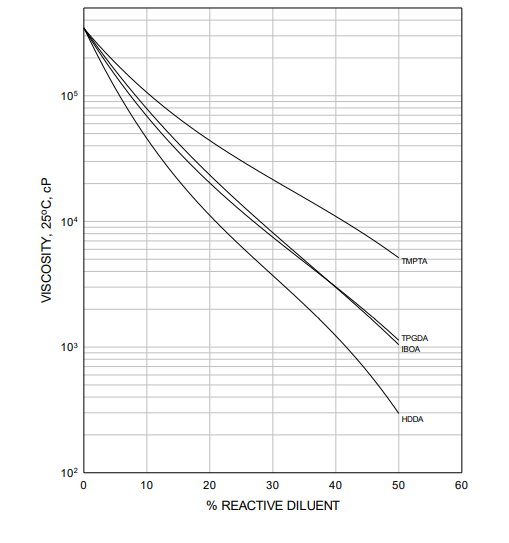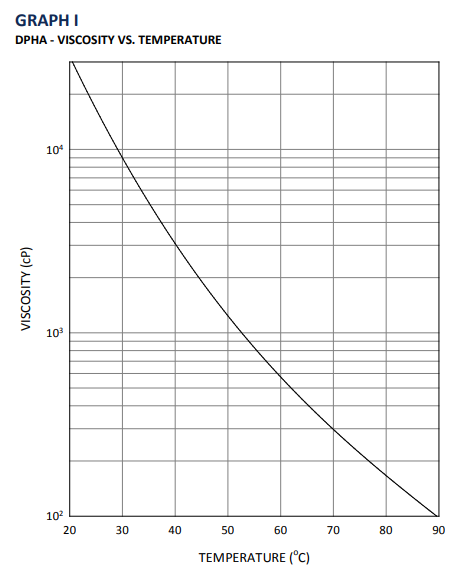Enhanced TDS
Identification & Functionality
- Blend
- No
- CASE Ingredients Functions
- Chemical Family
- Function
- Binder & Resin, Monomer
- Product Code
- MITM00348
- Single Ingredient
- Yes
- Technologies
- Product Families
Features & Benefits
Applications & Uses
- Application Method
- Coating End Applications
- Cure Method
- Markets
- Applications
- Product Applications
Formulated UV/EB curable products containing EBECRYL® 1258 may be applied via brush, roller, direct or reverse roll, offset gravure, metering rod, slot die, knife over roll, air knife, curtain, immersion and spin coating methods, as well as screen printing. EBECRYL® 1258 is recommended for use:
- In applications that must meet regulations for tin, heavy metal, and quinone content
- On hard to adhere to substrates
- In metal coatings
- In plastic coatings
- In exterior durable coatings
Properties
Technical Details & Test Data
- Viscosity Reduction With Reactive Diluents
EBECRYL® 1258 - Viscosity reduction with reactive diluents:

- Graph I shows the viscosity reduction of EBECRYL® 1258 with 1,6-hexanediol diacrylate (HDDA), isobornyl acrylate (IBOA), trimethylolpropane triacrylate (TMPTA), and tripropylene glycol diacrylate (TPGDA).
- Although viscosity reduction can be achieved with non-reactive solvents, reactive diluents are preferred because they are essentially 100 percent converted during UV/EB exposure to form a part of the coating or ink, thus reducing solvent emissions.
- The specific reactive diluents used will influence performance properties such as hardness and flexibility.
- Viscosity vs Temperature

Safety & Health
- Safety Precautions
Avoid contact with eyes and skin. Direct contact with EBECRYL® 1258 may cause moderate eye and skin irritation. Contact with skin may cause a cross-allergic reaction in persons already sensitized to acrylate materials. Wash thoroughly after handling. Keep container tightly closed. Use with adequate ventilation.
Packaging & Availability
Principal Information
- Group Principal Number
- S000001
- Principal
Storage & Handling
- Storage Conditions
- The recommended storage temperature range for EBECRYL® 1258 is 4°C to 40°C (39°F to 104°F). EBECRYL® 1258 should be taken not to expose the product to high temperature conditions, direct sunlight, ignition sources, oxidizing agents, alkalis or acids. This might cause uncontrollable polymerization of the product with the generation of heat.
- Storage and handling should be in stainless steel, amber glass, amber polyethylene or baked phenolic lined containers. Procedures that remove or displace oxygen from the material should be avoided. Do not store this material under an oxygen free atmosphere. Dry air is recommended to displace material removed from the container.
Other
- Appearance
- Clear liquid
- Appearance (SDS)
- Viscous liquid
- Color (SDS)
- Yellowish
- Insoluble in (SDS)
- Water
- Item Number
- Odor (SDS)
- Acrylate
- Other Hazards
- Polymerization may occur from excessive heat, contamination or exposure to direct sunlight.
- Protect from Freezing
- Yes
- Temperature Control
- Yes
- USA/DOT Proper Shipping Name
- Combustible liquid, N.O.S.
- USA/DOT Technical name (N.O.S.)
- Contains hydroxypropyl methacrylate
- USA/DOT UN Number
- NA1993
- Chemical Properties
Value Units Test Method / Conditions Hydroxypropyl Methacrylate Content 20.0 %(W/W) %(W/W) - Material Composition
Value Units Test Method / Conditions Oligomer Content 80.0 %(W/W) %(W/W) - Mechanical Properties
Value Units Test Method / Conditions Elongation at Break 41.0 % % Tensile Modulus 1012.0 MPa MPa Tensile Strength 31.6 MPa MPa - Optical Properties
Value Units Test Method / Conditions Color Scale 1.0 Gardner Gardner Gardner Color Scale - Physical Properties
Value Units Test Method / Conditions Density 1.08 g/mL g/mL at 25°C Glass Transition Temperature (Tg) 79.0 °C °C Storage Temperature 39.2-104.0 °F °F Viscosity 7100.0 mPa.s mPa.s at 60°C - SDS Physical and Chemical Properties
Value Units Test Method / Conditions Boiling Point (SDS) min. 100.0 °C °C Density (SDS) 1.1 g/cm³ g/cm³ Flash Point (SDS) 90.0 °C °C Cleveland Open Cup Vapor Pressure (SDS) max. 0.13 hPa hPa at 20°C Volatile Content (SDS) max. 0.5 % % - Shelf Life & Stability
Value Units Test Method / Conditions Shelf Life 0.0 d d
